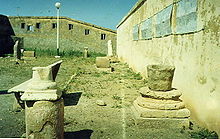Cartennae
 Ruins of Roman Cartennae | |
| Location | Algeria |
|---|---|
| Region | Chlef Province |
| Coordinates | 36°31′00″N 1°19′00″E / 36.5167°N 1.3167°E |

Cartennae[1] or Cartenna[2][3] was an ancient Carthaginian and Roman port at present-day Ténès, Algeria. Under the Romans, it was part of the province of Mauretania Caesariensis.
Name
Cartenna's name was variously recorded by the
History
Phoenician colony
Cartennae was established as a
Roman colony
After the
Tenes is supposed to have been a Phoenician settlement, and was a place of great importance during the Roman occupation, under the name of Cartenna. When
Marshal Bugeaud fixed on this spot to establish a French colony, a fine monument, the remains of the ramparts, and other ruins, were standing, but I understand that none are now in existence, except the foundations of the ramparts beneath the present town walls, and the cisterns now utilised by the French. An interesting monumental inscription now in Algiers, records that the Roman governor, Caius Fulcinius Optatus, successfully defended the colony against an attack by the Baquates, the Bakoutai of the Greeks, doubtless the wild Highlanders of the circumjacent Dahra. This tribe is specially mentioned by Pliny. Cartenna was rendered famous in the theological disputes which shook the African Christian Church to its centre. Rogatus,Donatist Bishop of Cartenna, established a new sect, modifying the Donatist heresy, and his followers were denominated Rogatists, after their founder. During the revolts of Firmus, who was subdued by Theodosius in 371, and by Gildo in 396, Rogatus took advantage of the general confusion to persecute his opponents; but his Sect did not take firm root, and during the episcopacy of Vincentius, his successor, only two African bishops were tainted with this particular heresy. Though all memorials of the Romans above ground at Tenes have been destroyed—by the Vandals, according to the French—a large portion of the old necropolis has been brought to light by the falling away of part of the cliff, probably during an earthquake. From the deck of the ship the tombs were quite perceptible, and the dark recesses ran some distance along the hill-side, sometimes assuming the form of galleries, along which no doubt vaults branched off on either side. Many of these vaults are used by the Government as magazines and cellars, and I heard that skeletons, and even pieces of clothing and jewelry, had been found in their recesses. At the other extremity of the bay I saw some remains of masonry, which probably mark the site of the Roman port.[3]
During the centuries of
in the years 372–375.Despite the continuation of its name in modern
Later history
Cartennae was sacked by the
Following the town's surrender to the invading French in 1843, the former site of Cartennae became the center of the new French town established in 1847.[10]
Religion
Cartennae was a
The earliest known bishops of Cartennae were Rogatus and Vincentius, who espoused the
References
Citations
- ^ a b Huss (2006).
- ^ MacBean (1773), s.v. "Cartenna".
- ^ a b Vereker (1871), p. 131.
- ^ a b Smith (1872).
- ^ Lipiński (2004), p. 408.
- ^ a b MacBean (1773).
- ^ As, for example, asserted by MacBean.[6]
- ^ a b Sale & al. (1744), p. 114.
- ^ Bencheneb, H. (24 April 2012). "Tanas". Tanas. Encyclopedia of Islam (2nd ed.). Brill.
- ^ a b c d e Playfair (1874), s.v. "Tenes".
- ^ Law (1978), p. [].
- ^ "Colonia - Livius". www.livius.org. Archived from the original on 2014-02-28. Retrieved 2018-01-29.
- ^ Mommsen, Theodore. The Provinces of the Roman Empire. Section: Africa
- ^ Detailed map showing Cartennae and Mostaganem location
- ^ Yver (1927).
- ^ Mesnage, Joseph (1859-1922); Toulotte, Anatole (1852-1907) (1912). Description de l'Afrique du Nord. Musées et collections archéologiques de l'Algérie et de la Tunisie. 17, L'Afrique chrétienne : évêchés et ruines antiques / d'après les manuscrits de Mgr Toulotte et les découvertes archéologiques les plus récentes ; par le P. J. Mesnage,... Paris: E. Leroux.
{{cite book}}: CS1 maint: numeric names: authors list (link) - ISBN 978-88-209-9070-1), p. 838
- ^ Cheney, David M. "Cartennae (Titular See) [Catholic-Hierarchy]". www.catholic-hierarchy.org. Retrieved 2018-01-29.
- ^ a b Stefano Antonio Morcelli, Africa christiana, Volume I, Brescia 1816, pp. 122–123
- ISBN 978-2-29624406-1), pp. 45–47
- ^ a b Anatole-Joseph Toulotte, Géographie de l'Afrique chrétienne. Maurétanies, Montreuil-sur-mer 1894, pp. 54-57
- ^ Lettera 87,10 (in Italian).
- ^ J. Mesnage, L'Afrique chrétienne, Paris 1912, pp. 469–470
- ^ Pius Bonifacius Gams, Series episcoporum Ecclesiae Catholicae, Leipzig 1931, p. 465
Bibliography
- Huss, Werner (2006), "Cartennae", Brill's New Pauly Encyclopedia of the Ancient World, Leiden: Brill.
- Laffi, Umberto (2007), Colonie e municipi nello Stato romano, Rome: Ed. di Storia e Letteratura, ISBN 978-8884983503.
- Law, Robin C.C. (1978), "North Africa in the Period of Phoenician and Greek Colonization", The Cambridge History of Africa, vol. II, ISBN 9780521215923.
- Lipiński, Edward (2004), Itineraria Phoenicia, Peeters Publishers, ISBN 978-90-429-1344-8
- MacBean, Alexander (1773), A Dictionary of Ancient Geography..., London: G. Robinson & T. Cadell.
- Mommsen, Theodore (1866), The Provinces of the Roman Empire, London
{{citation}}: CS1 maint: location missing publisher (link). - Playfair, Robert Lambert (1874), A Handbook for Travellers in Algeria, Murray's Handbooks, London: John Murray.
- Sale, George; et al. (1744), "The History of the Numidians...", An Universal History..., vol. VII, London: T. Osborne & al, Book IV, Ch. i.
- Smith, Philip (1872), "Cartenna", A Dictionary of Greek and Roman Geography..., vol. I, London: John Murray.
- Vereker, Charles Smyth (1871), Scenes in the Sunny South..., vol. II, London: Longmans, Green, & Co.
- Yver, G. (1927), "Tenes", The Encyclopedia of Islam..., vol. VIII, Leiden: E.J. Brill, ISBN 9004097961.
See also
- Mauretania Caesariensis
- Caesarea of Mauretania


